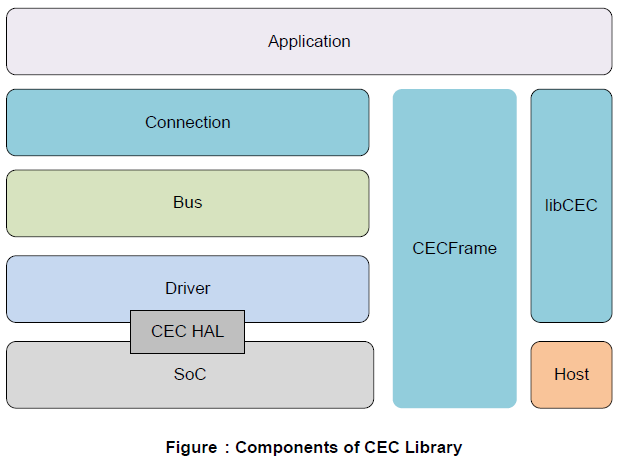 |
RDK Documentation (Open Sourced RDK Components)
|
 |
RDK Documentation (Open Sourced RDK Components)
|

Modules | |
| HDMI-CEC Applications | |
| The relation between Application, Connection and CEC-Bus is described in the figure. | |
| HDMI-CEC BUS | |
| HDMI-CEC CCEC | |
| HDMI-CEC Connection | |
| The connection API allows the application to access CEC Bus. A connection is a tap into the CEC bus. The application can use a connection to send raw bytes (in form of CECFrame) onto CEC bus or receive raw bytes from it. Each connection must have one and only one logical address. When application sends a CEC frame onto the connection, the connection's logical address will be used as the source address. On such connection, the application can only receive broadcast messages or unicast messages destined to the logical address of the connection. The application can open multiple connections, with one connection dedicated to each Role of the application. For example, a Set-top Box of three roles (Record, Playback, and Tuner) can open three connections, with each connection used to send/receive messages of the relevant role. Such Role-Connection mapping is transparent to the devices on the CEC bus. The external devices will not be able to tell if the CEC messages come from connections of a same or different physical device. All incoming CEEFrame arrived at the Physical CEC bus will be dispatched to all opened connections, based on the filtering criteria of the connection. By default, a connection with a given logical address filters out messages destined to other logical addresses. When a connection is opened without a given logical address, this connection will pick up all messages destined to the host device, regardless what roles the device has. This is useful if the application wants to sniff all available CEC packets from the bus. | |
| HDMI-CEC Daemon | |
| HDMI-CEC Driver APIs | |
| The Driver component access the HDMI-CEC SoC Driver via the CEC HAL API. Vendors are responsible in delivering a SoC Driver that conforms to the HAL API (see hdmi_cec_driver.h) | |
| HDMI-CEC Host | |
| HDMI-CEC Messages and Frames | |
| The CECFrame is a byte buffer that provides access to raw CEC bytes. CECFrame is guaranteed to be a complete CEC Message that has the necessary data blocks: . | |
| Multi-App Support | |
| Often , the application functionality (Record, Tune and Playback) is distributed across multiple components. In order for any component to have equivalent access to the HDMI-CEC bus, the library offers Multi-App support via IARM-Bus. This support is enabled by default, and can be disabled if desired. In essence, there is only one physical CEC bus on asystem. However, with the help of Connection, Logical CEC-Bus, and IARM-Bus, the CEC library can converge the CEC traffic from different Connections and Logical Buses before forwarding them to the single physical bus. This is illustrated by the diagram below. | |